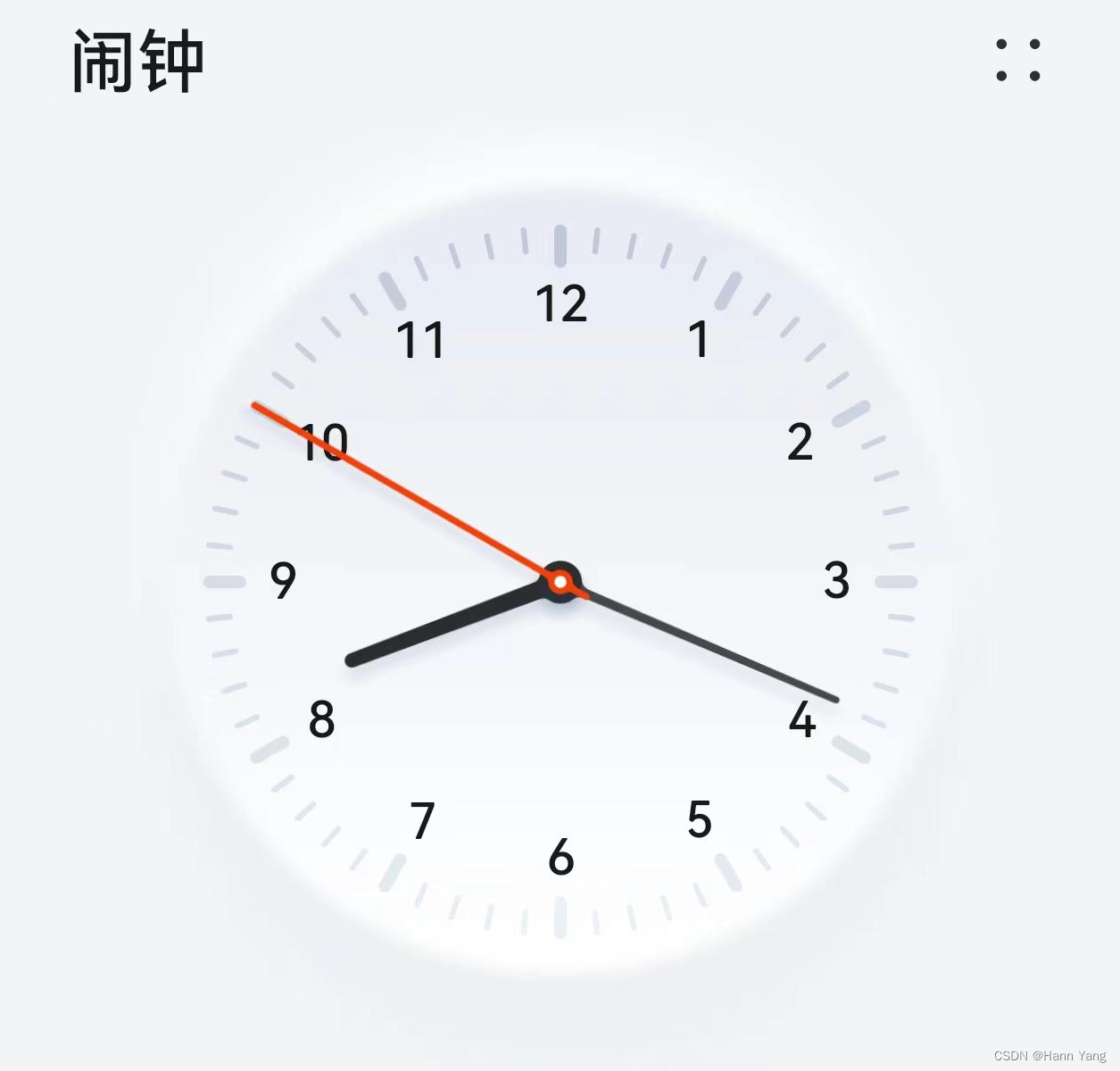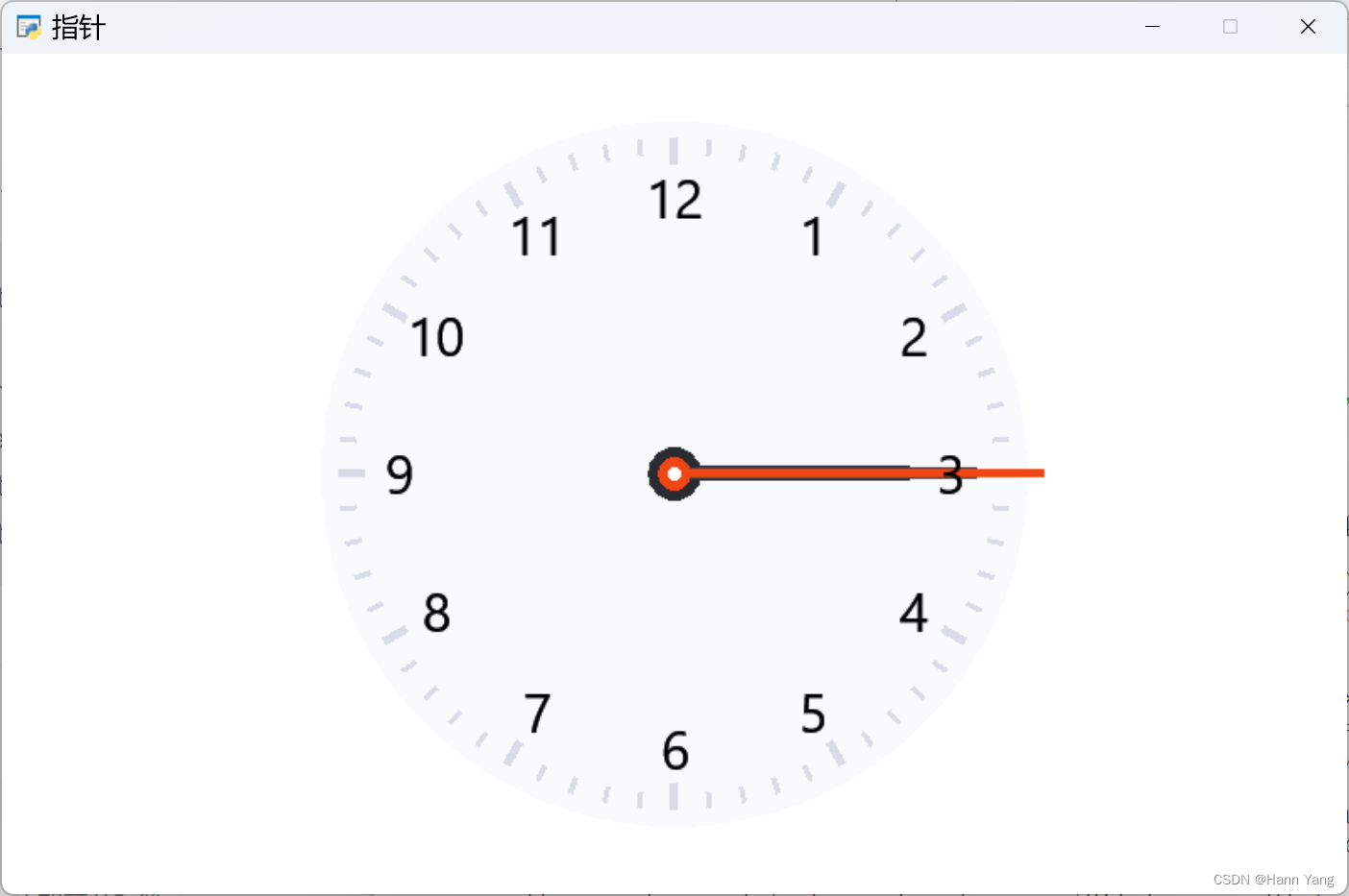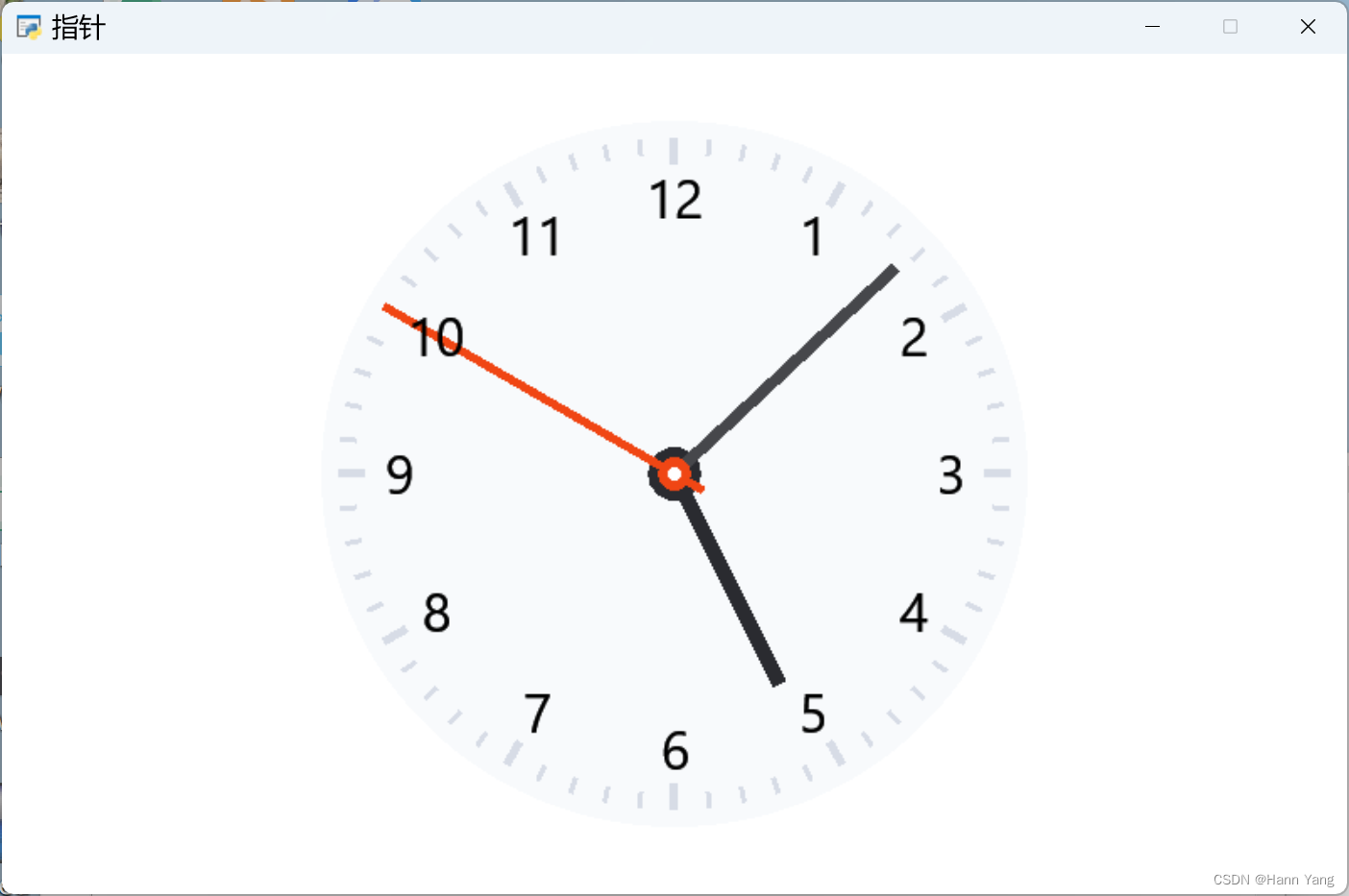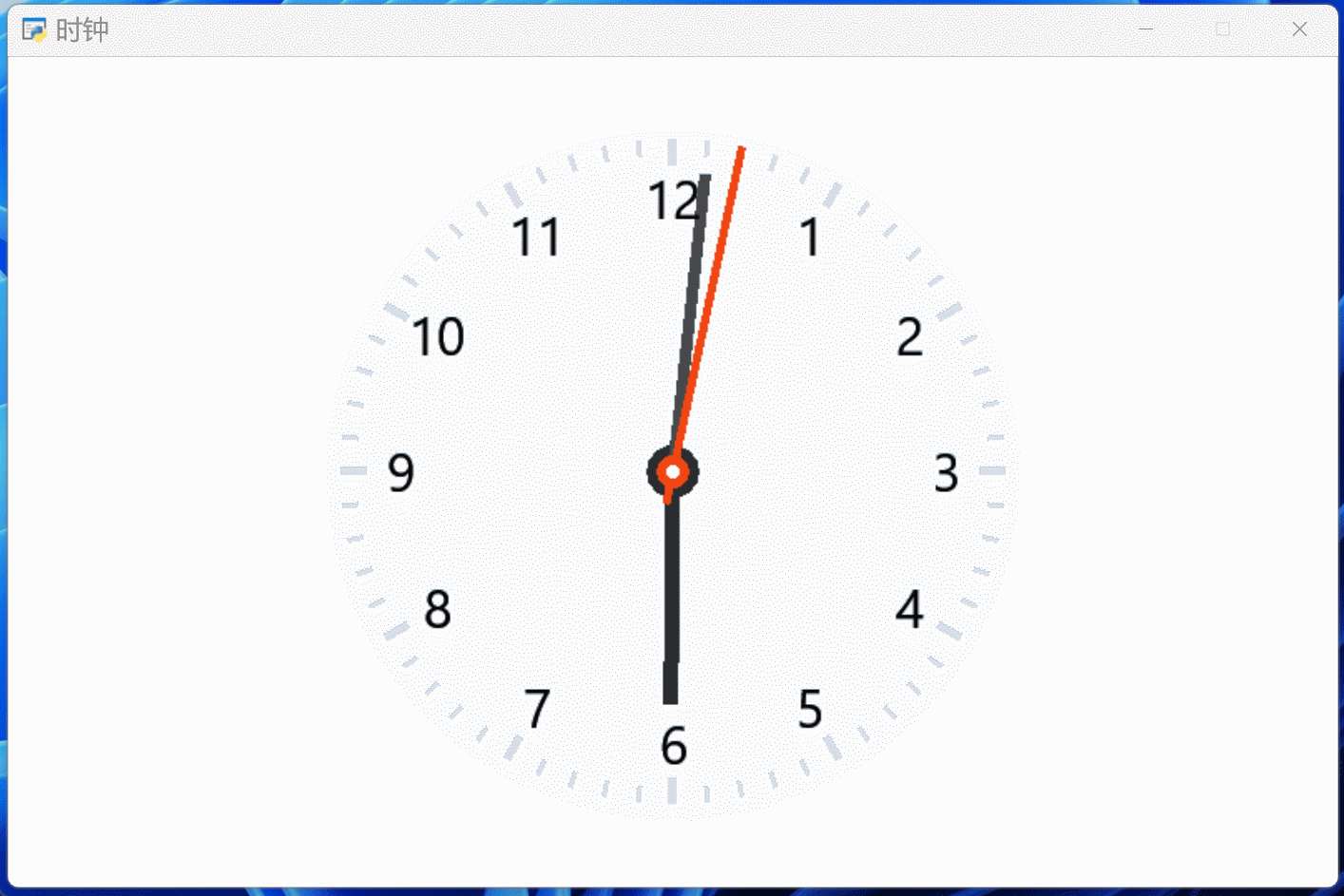首页 > Python资料 博客日记
Python 一步一步教你用pyglet仿制鸿蒙系统里的时钟
2024-03-15 21:00:04Python资料围观210次

目录
鸿蒙时钟
本篇将用python pyglet库复刻华为手机鸿蒙系统闹钟程序的时钟,先在上图中抓取出时分秒针及刻度、表盘的颜色RGB值:
bHour = (42, 43, 48, 255)
bMinute = (70, 71, 75, 255)
rSecond = (240, 70, 20, 255)
gScale = 215, 220, 230
wBackground = 248, 250, 252
1. 绘制圆盘
首先要画一圆Circle,并用直线Line等分成60份。
self.circle = pyglet.shapes.Circle(x, y, R, color=wBackground, batch=batch)
self.scales = [pyglet.shapes.Line(x, y, x+R*cos(i*Pi/30), y+R*sin(i*Pi/30),
width=2, color=gScales, batch=batch) for i in range(60)]
直线除圆心外的另一端点的坐标计算公式,如下图所示:

代码:
import pyglet
from math import pi, sin, cos
window = pyglet.window.Window(800, 500, caption='圆盘')
pyglet.gl.glClearColor(1, 1, 1, 1)
batch = pyglet.graphics.Batch()
R = 200
wBackground = 248, 250, 252
gScales = 215, 220, 230
class Watch:
def __init__(self, x, y):
self.circle = pyglet.shapes.Circle(x, y, R, color=wBackground, batch=batch)
self.scales = [pyglet.shapes.Line(x, y, x+R*cos(i*pi/30), y+R*sin(i*pi/30),
width=2, color=gScales, batch=batch) for i in range(60)]
@window.event
def on_draw():
window.clear()
batch.draw()
watch = Watch(window.width/2, window.height/2)
pyglet.app.run()
2. 创建表类
改造这个Watch类,可设置圆心和半径,并让它成为pyglet.window.Window的子类。

import pyglet
from math import sin, cos, pi
wBackground = (248, 250, 252, 255)
gScales = (215, 220, 230, 255)
class Watch(pyglet.window.Window):
def __init__(self, x, y, R=200, width=800, height=500, caption='圆盘'):
super().__init__(width, height, caption=caption)
pyglet.gl.glClearColor(1, 1, 1, 1)
self.batch = pyglet.graphics.Batch()
self.circle = pyglet.shapes.Circle(x, y, R,
color=wBackground, batch=self.batch)
self.scales = [pyglet.shapes.Line(x, y, x+R*cos(i*pi/30), y+R*sin(i*pi/30),
width=2, color=gScales, batch=self.batch) for i in range(60)]
def on_draw(self):
self.clear()
self.batch.draw()
def run(self):
pyglet.app.run()
watch = Watch(500, 300, 150)
watch.run()3. 绘制刻度
扩大圆面并缩短和加粗直线,表盘和刻度的大致轮廓就出现了。

代码:
import pyglet
from math import sin, cos, pi
wBackground = (248, 250, 252, 255)
gScales = (215, 220, 230, 255)
class Watch(pyglet.window.Window):
def __init__(self, x, y, R=200, width=800, height=500, caption='刻度'):
super().__init__(width, height, caption=caption)
pyglet.gl.glClearColor(1, 1, 1, 1)
self.batch = pyglet.graphics.Batch()
self.circle = pyglet.shapes.Circle(x, y, R*1.05,
color=wBackground, batch=self.batch)
self.scales = [pyglet.shapes.Line(x+R*cos(i*pi/30), y+R*sin(i*pi/30),
x+R*0.95*cos(i*pi/30), y+0.95*R*sin(i*pi/30),
width=3, color=gScales, batch=self.batch) for i in range(60)]
for i, scale in enumerate(self.scales):
if i%5==0:
scale.width, scale.x2, scale.y2 = 5, x+R*0.92*cos(i*pi/30), y+0.92*R*sin(i*pi/30)
def on_draw(self):
self.clear()
self.batch.draw()
def run(self):
pyglet.app.run()
watch = Watch(400, 250)
watch.run()4. 刻度数值
在整点的刻度值边上用标签标注上1~12的数字。
self.labels = [pyglet.text.Label(str((2-i)%12+1), font_size=24, color=(0,0,0,255),
x=x+R*0.82*cos(i*pi/6), y=y+0.82*R*sin(i*pi/6)+5, anchor_x='center',
anchor_y='center', batch=self.batch) for i in range(12)]

代码:
import pyglet
from math import sin, cos, pi
wBackground = (248, 250, 252, 255)
gScales = (215, 220, 230, 255)
rSecond = (240, 70, 20, 255)
class Watch(pyglet.window.Window):
def __init__(self, x, y, R=200, width=800, height=500, caption='指针'):
super().__init__(width, height, caption=caption)
pyglet.gl.glClearColor(1, 1, 1, 1)
self.batch = pyglet.graphics.Batch()
self.circle = pyglet.shapes.Circle(x, y, R*1.05, color=wBackground, batch=self.batch)
self.scales = [pyglet.shapes.Line(x+R*cos(i*pi/30), y+R*sin(i*pi/30),
x+R*0.95*cos(i*pi/30), y+0.95*R*sin(i*pi/30),
width=3, color=gScales, batch=self.batch) for i in range(60)]
for i,scale in enumerate(self.scales):
if i%5==0:
scale.width, scale.x2, scale.y2 = 5, x+R*0.92*cos(i*pi/30), y+0.92*R*sin(i*pi/30)
self.labels = [pyglet.text.Label(str((2-i)%12+1), font_size=R*0.12, color=(0,0,0,255),
x=x+R*0.82*cos(i*pi/6), y=y+0.82*R*sin(i*pi/6)-R*0.06, anchor_x='center',
batch=self.batch) for i in range(12)]
def on_draw(self):
self.clear()
self.batch.draw()
def run(self):
pyglet.app.run()
watch = Watch(400, 250)
watch.run()5. 添加指针
时、分、秒针,用三个圆三条直线来表示。
self.circle1 = pyglet.shapes.Circle(x, y, R*0.08, color=bHour)
self.hour = pyglet.shapes.Line(x, y, x+R*0.7, y, width=9, color=bHour)
self.minute = pyglet.shapes.Line(x, y, x+R*0.9, y, width=7, color=bMinute)
self.second = pyglet.shapes.Line(x, y, x+R*1.1, y, width=5, color=rSecond)
self.circle2 = pyglet.shapes.Circle(x, y, R*0.05, color=rSecond)
self.circle3 = pyglet.shapes.Circle(x, y, R*0.02, color=wWhite)
不用担心秒针长过表盘圆面,转动前会作“移动”处理。

代码:
import pyglet
from math import sin, cos, pi
wBackground = (248, 250, 252, 255)
gScales = (215, 220, 230, 255)
rSecond = (240, 70, 20, 255)
bMinute = (70, 71, 75, 255)
bHour = (42, 43, 48, 255)
wWhite = (255, 255, 255, 255)
class Watch(pyglet.window.Window):
def __init__(self, x, y, R=200, width=800, height=500, caption='指针'):
super().__init__(width, height, caption=caption)
pyglet.gl.glClearColor(1, 1, 1, 1)
self.batch = pyglet.graphics.Batch()
self.circle = pyglet.shapes.Circle(x, y, R*1.05, color=wBackground, batch=self.batch)
self.scales = [pyglet.shapes.Line(x+R*cos(i*pi/30), y+R*sin(i*pi/30),
x+R*0.95*cos(i*pi/30), y+0.95*R*sin(i*pi/30),
width=3, color=gScales, batch=self.batch) for i in range(60)]
for i,scale in enumerate(self.scales):
if i%5==0:
scale.width, scale.x2, scale.y2 = 5, x+R*0.92*cos(i*pi/30), y+0.92*R*sin(i*pi/30)
self.labels = [pyglet.text.Label(str((2-i)%12+1), font_size=R*0.12, color=(0,0,0,255),
x=x+R*0.82*cos(i*pi/6), y=y+0.82*R*sin(i*pi/6)-R*0.06, anchor_x='center',
batch=self.batch) for i in range(12)]
self.circle1 = pyglet.shapes.Circle(x, y, R*0.08, color=bHour, batch=self.batch)
self.hour = pyglet.shapes.Line(x, y, x+R*0.7, y, width=9, color=bHour, batch=self.batch)
self.minute = pyglet.shapes.Line(x, y, x+R*0.9, y, width=7, color=bMinute, batch=self.batch)
self.second = pyglet.shapes.Line(x, y, x+R*1.1, y, width=5, color=rSecond, batch=self.batch)
self.circle2 = pyglet.shapes.Circle(x, y, R*0.05, color=rSecond, batch=self.batch)
self.circle3 = pyglet.shapes.Circle(x, y, R*0.02, color=wWhite, batch=self.batch)
def on_draw(self):
self.clear()
self.batch.draw()
def run(self):
pyglet.app.run()
watch = Watch(400, 250)
watch.run()
6. 转动指针
时、分、秒针的转动运用Line控件的旋转属性.rotation,这种方法要比修改端点坐标要方便。
默认的旋转中心是直线的左端点,属性.anchor_position可以修改中心坐标。
self.second.anchor_position = (R*0.1, 0)
self.second.rotation = 210
self.minute.rotation = 24
self.hour.rotation = 160

代码:
import pyglet
from math import sin, cos, pi
wBackground = (248, 250, 252, 255)
gScales = (215, 220, 230, 255)
rSecond = (240, 70, 20, 255)
bMinute = (70, 71, 75, 255)
bHour = (42, 43, 48, 255)
wWhite = (255, 255, 255, 255)
class Watch(pyglet.window.Window):
def __init__(self, x, y, R=200, width=800, height=500, caption='指针'):
super().__init__(width, height, caption=caption)
pyglet.gl.glClearColor(1, 1, 1, 1)
self.batch = pyglet.graphics.Batch()
self.circle = pyglet.shapes.Circle(x, y, R*1.05, color=wBackground, batch=self.batch)
self.scales = [pyglet.shapes.Line(x+R*cos(i*pi/30), y+R*sin(i*pi/30),
x+R*0.95*cos(i*pi/30), y+0.95*R*sin(i*pi/30),
width=3, color=gScales, batch=self.batch) for i in range(60)]
for i,scale in enumerate(self.scales):
if i%5==0:
scale.width, scale.x2, scale.y2 = 5, x+R*0.92*cos(i*pi/30), y+0.92*R*sin(i*pi/30)
self.labels = [pyglet.text.Label(str((2-i)%12+1), font_size=R*0.12, color=(0,0,0,255),
x=x+R*0.82*cos(i*pi/6), y=y+0.82*R*sin(i*pi/6)-R*0.06, anchor_x='center',
batch=self.batch) for i in range(12)]
self.circle1 = pyglet.shapes.Circle(x, y, R*0.08, color=bHour, batch=self.batch)
self.hour = pyglet.shapes.Line(x, y, x+R*0.7, y, width=9, color=bHour, batch=self.batch)
self.minute = pyglet.shapes.Line(x, y, x+R*0.9, y, width=7, color=bMinute, batch=self.batch)
self.second = pyglet.shapes.Line(x, y, x+R*1.1, y, width=5, color=rSecond, batch=self.batch)
self.circle2 = pyglet.shapes.Circle(x, y, R*0.05, color=rSecond, batch=self.batch)
self.circle3 = pyglet.shapes.Circle(x, y, R*0.02, color=wWhite, batch=self.batch)
self.second.anchor_position = (R*0.1, 0)
self.second.rotation = 210
self.minute.rotation = 24
self.hour.rotation = 160
def on_draw(self):
self.clear()
self.batch.draw()
def run(self):
pyglet.app.run()
watch = Watch(400, 250)
watch.run()7. 联动时间
联动系统时钟,使用datetime.now()获取当前时间的时、分、秒的值。
now = datetime.now()
h, m, s = now.hour, now.minute, now.second
self.second.rotation = -90 + s*6
self.minute.rotation = -90 + m*6 + s/10
self.hour.rotation = -90 + h%12*30 + m/2

代码:
import pyglet
from math import sin, cos, pi
from datetime import datetime
wBackground = (248, 250, 252, 255)
gScales = (215, 220, 230, 255)
rSecond = (240, 70, 20, 255)
bMinute = (70, 71, 75, 255)
bHour = (42, 43, 48, 255)
wWhite = (255, 255, 255, 255)
class Watch(pyglet.window.Window):
def __init__(self, x, y, R=200, width=800, height=500, caption='指针'):
super().__init__(width, height, caption=caption)
pyglet.gl.glClearColor(1, 1, 1, 1)
self.batch = pyglet.graphics.Batch()
self.circle = pyglet.shapes.Circle(x, y, R*1.05, color=wBackground, batch=self.batch)
self.scales = [pyglet.shapes.Line(x+R*cos(i*pi/30), y+R*sin(i*pi/30),
x+R*0.95*cos(i*pi/30), y+0.95*R*sin(i*pi/30),
width=3, color=gScales, batch=self.batch) for i in range(60)]
for i,scale in enumerate(self.scales):
if i%5==0:
scale.width, scale.x2, scale.y2 = 5, x+R*0.92*cos(i*pi/30), y+0.92*R*sin(i*pi/30)
self.labels = [pyglet.text.Label(str((2-i)%12+1), font_size=R*0.12, color=(0,0,0,255),
x=x+R*0.82*cos(i*pi/6), y=y+0.82*R*sin(i*pi/6)-R*0.06, anchor_x='center',
batch=self.batch) for i in range(12)]
self.circle1 = pyglet.shapes.Circle(x, y, R*0.08, color=bHour, batch=self.batch)
self.hour = pyglet.shapes.Line(x, y, x+R*0.7, y, width=9, color=bHour, batch=self.batch)
self.minute = pyglet.shapes.Line(x, y, x+R*0.9, y, width=7, color=bMinute, batch=self.batch)
self.second = pyglet.shapes.Line(x, y, x+R*1.1, y, width=5, color=rSecond, batch=self.batch)
self.circle2 = pyglet.shapes.Circle(x, y, R*0.05, color=rSecond, batch=self.batch)
self.circle3 = pyglet.shapes.Circle(x, y, R*0.02, color=wWhite, batch=self.batch)
self.second.anchor_position = (R*0.1, 0)
self.update()
def update(self):
now = datetime.now()
h, m, s = now.hour, now.minute, now.second
self.second.rotation = -90 + s*6
self.minute.rotation = -90 + m*6 + s/10
self.hour.rotation = -90 + h%12*30 + m/2
def on_draw(self):
self.clear()
self.batch.draw()
def run(self):
pyglet.app.run()
watch = Watch(400, 250)
watch.run()8. 运行时钟
使用pyglet.clock.schedule_interval(self.update, 0.2)每秒更新5次。
总得来说,本次复刻比较完美,但直线控件在非水平或垂直状态,特别是小夹角时锯齿很严重。

完整代码:
import pyglet
from math import sin, cos, pi
from datetime import datetime
class Watch(pyglet.window.Window):
def __init__(self, x, y, R=200, width=800, height=500, caption='时钟'):
super().__init__(width, height, caption=caption)
wBackground = (248, 250, 252, 255)
gScales = (215, 220, 230, 255)
rSecond = (240, 70, 20, 255)
bMinute = (70, 71, 75, 255)
bHour = (42, 43, 48, 255)
wWhite = (255, 255, 255, 255)
pyglet.gl.glClearColor(1, 1, 1, 1)
self.batch = pyglet.graphics.Batch()
self.circle = pyglet.shapes.Circle(x, y, R*1.05, color=wBackground, batch=self.batch)
self.scales = [pyglet.shapes.Line(x+R*cos(i*pi/30), y+R*sin(i*pi/30),
x+R*0.95*cos(i*pi/30), y+0.95*R*sin(i*pi/30),
width=3, color=gScales, batch=self.batch) for i in range(60)]
for i,scale in enumerate(self.scales):
if i%5==0:
scale.width, scale.x2, scale.y2 = 5, x+R*0.92*cos(i*pi/30), y+0.92*R*sin(i*pi/30)
self.labels = [pyglet.text.Label(str((2-i)%12+1), font_size=R*0.12, color=(0,0,0,255),
x=x+R*0.82*cos(i*pi/6), y=y+0.82*R*sin(i*pi/6)-R*0.06, anchor_x='center',
batch=self.batch) for i in range(12)]
self.circle1 = pyglet.shapes.Circle(x, y, R*0.08, color=bHour, batch=self.batch)
self.hour = pyglet.shapes.Line(x, y, x+R*0.7, y, width=9, color=bHour, batch=self.batch)
self.minute = pyglet.shapes.Line(x, y, x+R*0.9, y, width=7, color=bMinute, batch=self.batch)
self.second = pyglet.shapes.Line(x, y, x+R*1.1, y, width=5, color=rSecond, batch=self.batch)
self.circle2 = pyglet.shapes.Circle(x, y, R*0.05, color=rSecond, batch=self.batch)
self.circle3 = pyglet.shapes.Circle(x, y, R*0.02, color=wWhite, batch=self.batch)
self.second.anchor_position = (R*0.1, 0)
self.update(self.event)
pyglet.clock.schedule_interval(self.update, 0.2)
def update(self, event):
now = datetime.now()
h, m, s = now.hour, now.minute, now.second
self.second.rotation = -90 + s*6
self.minute.rotation = -90 + m*6 + s/10
self.hour.rotation = -90 + h%12*30 + m/2
def on_draw(self):
self.clear()
self.batch.draw()
def run(self):
pyglet.app.run()
watch = Watch(400, 250)
watch.run()
完
标签:
相关文章
最新发布
- 光流法结合深度学习神经网络的原理及应用(完整代码都有Python opencv)
- Python 图像处理进阶:特征提取与图像分类
- 大数据可视化分析-基于python的电影数据分析及可视化系统_9532dr50
- 【Python】入门(运算、输出、数据类型)
- 【Python】第一弹---解锁编程新世界:深入理解计算机基础与Python入门指南
- 华为OD机试E卷 --第k个排列 --24年OD统一考试(Java & JS & Python & C & C++)
- Python已安装包在import时报错未找到的解决方法
- 【Python】自动化神器PyAutoGUI —告别手动操作,一键模拟鼠标键盘,玩转微信及各种软件自动化
- Pycharm连接SQL Sever(详细教程)
- Python编程练习题及解析(49题)
点击排行
- 版本匹配指南:Numpy版本和Python版本的对应关系
- 版本匹配指南:PyTorch版本、torchvision 版本和Python版本的对应关系
- Anaconda版本和Python版本对应关系(持续更新...)
- 相关性分析——Pearson相关系数+热力图(附data和Python完整代码)
- Python 可视化 web 神器:streamlit、Gradio、dash、nicegui;低代码 Python Web 框架:PyWebIO
- Windows上安装 Python 环境并配置环境变量 (超详细教程)
- Python与PyTorch的版本对应
- 安装spacy+zh_core_web_sm避坑指南

